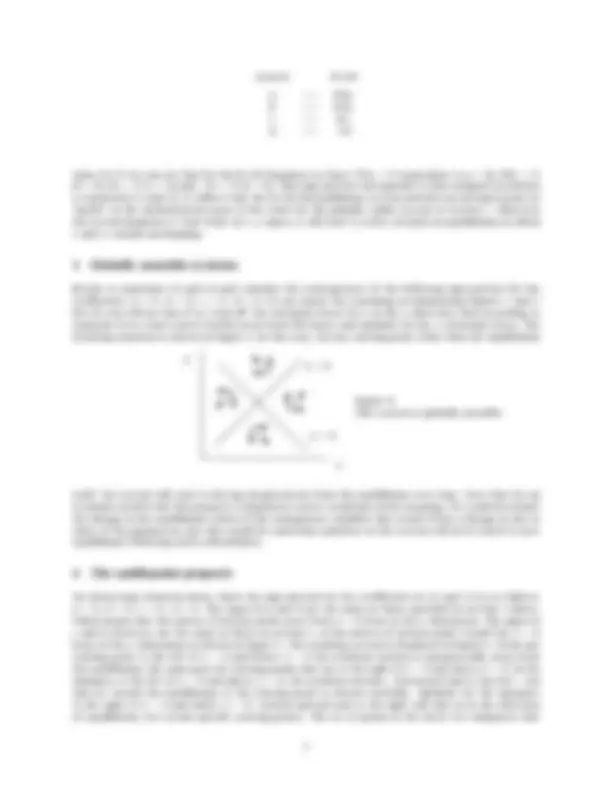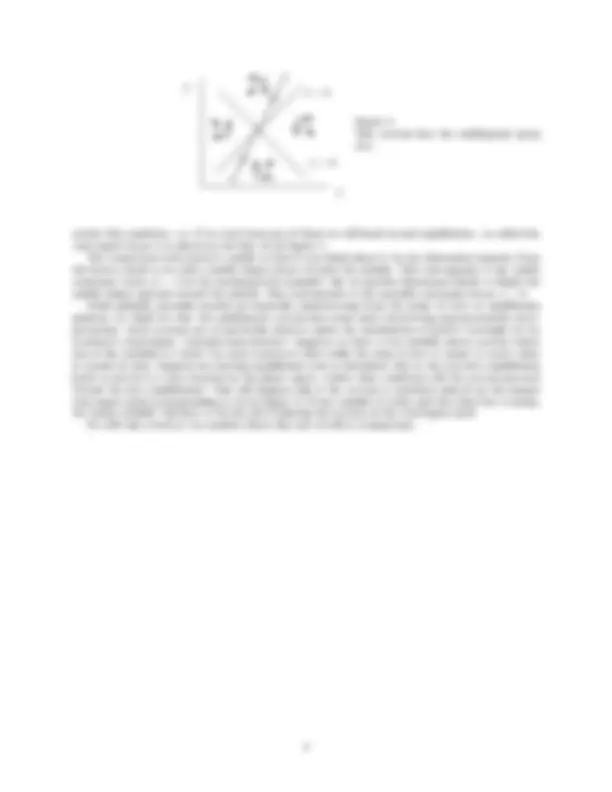




Study with the several resources on Docsity

Earn points by helping other students or get them with a premium plan


Prepare for your exams
Study with the several resources on Docsity

Earn points to download
Earn points by helping other students or get them with a premium plan
Community
Ask the community for help and clear up your study doubts
Discover the best universities in your country according to Docsity users
Free resources
Download our free guides on studying techniques, anxiety management strategies, and thesis advice from Docsity tutors
Material Type: Notes; Professor: Cottrell; Class: Macroeconomic Dynamics; Subject: Economics; University: Wake Forest University; Term: Unknown 1989;
Typology: Study notes
1 / 4

This page cannot be seen from the preview
Don't miss anything!



Economics 211 Allin Cottrell
Take a system in which the time derivatives of the two variables x and y are functions of the levels of both x and y. dx dt
≡ x˙ = ax + by + h (1)
dy dt
≡ y˙ = cx + dy + k (2)
Let the signs of the coefficients be as follows: a < 0 , b > 0 , c < 0 , d < 0 , k > 0 (the sign of h is immaterial). Consider the locus of points in x, y space such that ˙x = 0, the stationary locus for x. It is obtained by setting the left-hand side of (1) to zero, which yields
y = −
a b x −
h b
Given the signs of the coefficients, the slope of this locus, −a/b, is positive: the higher is the value of x, the greater must be the value of y to hold x constant (i.e. to hold ˙x = 0). Consider the thought experiment of taking a small step off the stationary locus for x in the x direction (as from A to B in Figure 1). At point A, dx/dt = 0 (by construction, since we’re on the ˙x = 0
x
y
x ˙ = 0
Figure 1: Stationary locus for x
locus). At point B, y remains unchanged but the value of x is increased relative to A. Look at equation (1) and remember that a < 0: whenever x is increased but y is held constant, ˙x must fall. But this means that ˙x must be negative at B, which in turn means that x is falling over time, and we tend to move back toward the stationary locus. The stationary locus for y is derived in the same manner. It is represented by
y = −
c d
x −
k d
and has negative slope −c/d. Repeating the above thought experiment we have the situation shown in Figure 2. Looking at equation (2) and remembering that d < 0 we can infer that a vertical jump from A to B will make ˙y go negative, so that y falls and we tend to return to the stationary locus. Putting two and two together we get the setup shown in Figure 3. This phase diagram— as it is called— exhibits global stability. The intersection of the two stationary loci represents the equilibrium point for the system, where both x and y remain unchanging. The arrows of motion are such that wherever we start out in the phase space, we are always drawn inexorably toward the equilibrium.
x
y
y ˙ = 0
Figure 2: Stationary locus for y
x
y x˙ = 0
y˙ = 0
Figure 3: This system is globally stable
2 An interpretation: IS–LM
Consider this simple linear IS–LM model:
L = (l 1 y + l 2 r )P l 1 > 0 , l 2 < 0 (3) I = i 0 + i 1 r i 0 > 0 , i 1 < 0 (4) S = sy 0 < s < 1 (5)
The endogenous variables are y (real output), I (real investment), S (real saving), L (the demand for money) and r (the rate of interest). The exogenous variables are M (nominal money stock) and P (the general price level). In equilibrium, the model is closed by specifying that I = S and L = M, but suppose that when the system is out of equilibrium the variables r and y obey the following dynamic equations:
r˙ = k(L − M) k > 0 (6) y˙ = h(I − S) h > 0 (7)
This is to say that the interest rate is driven up (down) by an excess demand (supply) of money, while real output is driven up (down) by an excess (shortfall) of investment in relation to saving. This seems like a plausible set of dynamics. Now let us analyse the disequilibrium dynamics of the system. Using (3) in (6) yields
r˙ = P kl 2 r + P kl 1 y − kM (8)
while using (4) and (5) in (7) gives y˙ = hi 1 r − hsy + hi 0 (9) Note that equations (8) and (9) are in the same form as the generic equations of motion (1) and (2) above: the time derivatives of r and y depend in a linear manner on the levels of r and y. The coefficients of the generic equations of motion correspond to those of our disequilibrium dynamic equations for r and y as shown in the following table. By inspecting the sign specifications in equa-
x
y x˙ = 0
y˙ = 0
Figure 5: This system has the saddlepoint prop- erty
satisfy this condition — i.e. if we start from any of them we will head toward equilibrium— is called the convergent locus ; it is shown as the line AA in Figure 5. The connection with a horse’s saddle is clear if you think about it. In one dimension (namely, from the horse’s head to its tail) a saddle slopes down towards the middle. This corresponds to the stable stationary locus ( ˙y = 0 in the mathematical example). But in another dimension (flank to flank) the saddle slopes upward toward the middle. This corresponds to the unstable stationary locus, ˙x = 0. While globally unstable models are basically uninteresting from the point of view of equilibrium analysis, we shall see that the saddlepoint system has some quite interesting macroeconomic inter- pretations. Such systems are of particular interest under the assumption of perfect foresight (or its stochastic counterpart, ‘rational expectations’). Suppose we have a two-variable macro system where one of the variables is ‘sticky’ for some reason or other while the other is free to ‘jump’ to a new value at a point in time. Suppose an existing equilibrium state is disturbed, that is, the system’s equilibrium point is moved to a new location in the phase space. Under what condition will the system proceed toward the new equilibrium? This will happen only if the system is somehow placed on the unique convergent path (corresponding to AA in Figure 5). If one variable is sticky and the other free to jump, the ‘jump variable’ will have to do the job of placing the system on the convergent path. We will take a look at two models where this sort of effect is important.